Methodological Approach To Substantiating The Priorities Of Balanced Development Of Agricultural Production
Abstract
The development of agricultural production is a strategic task in maintaining the region economic growth. Considering statistics, some branches of the Russian agro-industrial complex are among the most lagging behind in their economic development in comparison with the countries of the European Union and the United States. To get out of the crisis, a whole range of measures is needed and the use of significant investment funds, which the enterprises of the industry do not have. In this regard, it becomes necessary to develop a set of indicators that took into account the modern conditions for the development of agaric production and made it possible to take into account the characteristic features of a certain branch of the agaric sector. The study substantiated indicators for carrying out a botryological assessment of the formation of dynamics in certain classes; clustering of medium and large regional producers of livestock production was carried out. The results of the botryological assessment made it possible to identify the cumulative relationship of the influence of factors on the development of the studied industry. The article presents an assessment of the efficiency of the milk production cycle due to intensification with the allocation of three clusters, which made it possible to identify the dependence of the annual milk yield on unit costs. The results obtained may be of interest to researchers in the field of agricultural production and serve as the basis for the development of an effective cluster policy for sustainable development of the agro-industrial complex.
Keywords: Balanced development, agar production, livestock industry, efficiency
Introduction
The livestock industry is one of the backbone branches of agricultural production, which is due to the nutritional value of these products and the necessary nutrient for maintaining vital activity. A distinctive feature of dairy cattle breeding from other sectors of agriculture is its high capital intensity, labour intensity and long-term return on investment (Bondarenko & Takhumova, 2019; Folomyev, 1995; Takhumova et al., 2018).
Problem Statement
Currently, the dairy sector of the Russian economy is one of the most lagging behind in its economic development from the countries of the European Union and the United States. Moreover, this lag is quite significant, and in order to overcome the crisis, it is necessary to develop a whole range of measures and use significant investment funds, which the industry enterprises currently do not have. In this case, it becomes necessary to select and substantiate the directions of innovative development, which in the near future will be able to give the necessary effect and refer to the experience of the most developed regions of the Russian Federation in this direction. One of these regions is the Krasnodar Territory.
The conducted economic assessment of small and medium-sized agricultural enterprises of the Krasnodar Territory, the main activity of which is the production and sale of whole milk, revealed a significant variation in technical, economic, technological indicators in their activities. To distinguish a group of lagging farms, whose activities require significant adjustment, and a group of advanced organizations that can play the role of potential landmarks, we used a botryological assessment method based on systematizing heterogeneous statistical aggregates into certain groups (clusters), combined by a number of similar features.
Research Questions
Expansion of methodological approaches to assessing the balanced development of agricultural production in the region is determined as the main goal of the work. In the context of the expansion of the scientific and methodological base for the regional development of agricultural production, sufficient attention is paid to the issues of sustainable development of agricultural sectors. However, opinion is limited to the problems of balanced development only within the framework of maintaining economic growth of regional development indicators and not always taking into account the interconnection and the need for proportional growth, a number of criteria and indicators regarding the livestock industry. The epistemological main balanced development is economic theory, the founders of which in this direction were such scientists as: Abalkin (2012), Belokh and Rusakov (1986), Gershun and Nefedieva (2007), Leontiev (2002), Tebekin and Anastasov (2017), Takhumova (2020), Schumpeter (1982) and others. A large number of works are devoted to the study of various aspects of the development of cluster initiatives of territorial economic systems and the state. In a study by Falck et al. (2010) assesses the cluster-oriented policy introduced in Bavaria, Germany, in 1999. We consider this technique to be applicable to this study.
Purpose of the Study
The data characterizing the efficiency of milk production is influenced by many external and internal factors. In the course of the study, we drew up a diagram of a set of factors and their relationships (Figure 1).
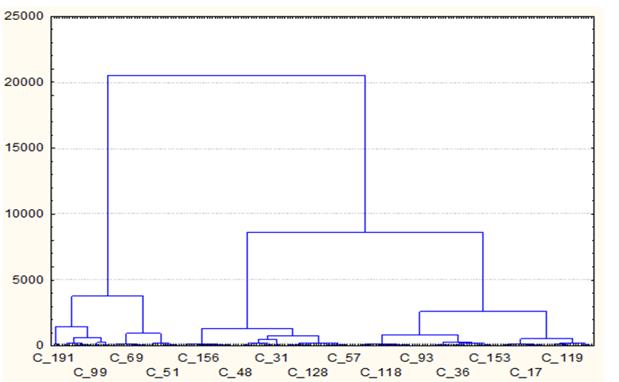
To determine the promising directions for the development of dairy cattle breeding in the region, it was necessary to identify the maximum values of the factors (which correspond to the aggregate of farms of the third class) and to determine the minimum indicators corresponding to farms of the first cluster.
When conducting correlation studies, the cost per animal was chosen as the main factor. The productive parameters were milk yield per animal, prime cost and profitability of milk production.
Research Methods
As a result of the expert analysis, factors were identified that have a significant impact on the process under study and characterize the sufficient level of development of dairy cattle breeding in the region. They included:
- production costs per productive animal;
- annual milk yield per one productive animal;
- bioconversion of feed, c of feed;
- livestock of animals per unit of farmland used;
- specific cost of milk production;
- profitability of milk production.
Figure 2 shows a dendrogram of medium and large regional organizations producing whole milk.
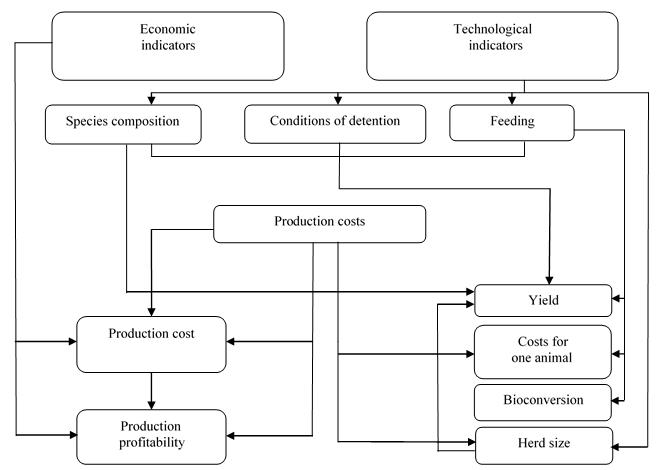
When applying the k-means method with a pooling distance of 7500, three clusters were obtained (52, 58 and 54 units). The obtained data of the analysis of variance confirm the significance of the influence of the variables on the formation of the final result (Table 1).
The correctness of the presented grouping is illustrated in Figure 3.
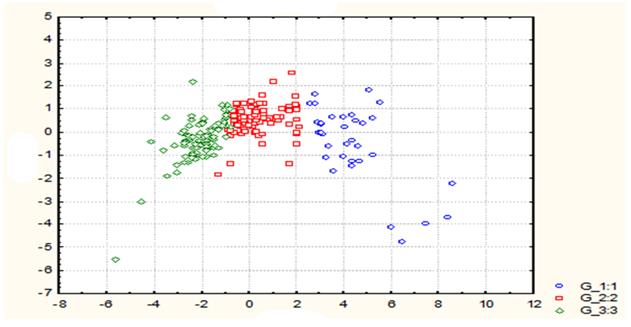
The obtained result testifies to the presence of a cumulative relationship of the influence of factors on the process under study. The next stage of the study was to identify the correlation between the initial variables in each selected class.
Analysing the characteristics of clusters (Table 2), it can be noted that the best studied indicators are in the third-class farms, and the worst in the first.
To determine the promising directions for the development of dairy cattle breeding in the region, it was necessary to identify the maximum values of the factors (which correspond to the aggregate of farms of the third class) and to determine the minimum indicators corresponding to the farms of the first cluster. When conducting correlation studies, the cost per animal was chosen as the main factor.
The productive parameters were milk yield per animal, cost price and profitability of milk production.
Calculation of the impact of the intensification process on the main technical and economic variables of milk production are shown in Table 3.
A graphical analysis of the results (Figure 4) demonstrates that with an increase in unit costs, an increase in milk yield is observed in the clusters formed. It should also be noted that, the curve of the third classification group is located above, relative to the other two clusters. This is due to the presence of intensive production in organizations, as a result of which, in general, for these economic entities there is an increase in the volume of milk yield.
Graphical dependences of the profitability of milk production on unit costs are identical to the curves of changes in animal productivity (Figure 5).
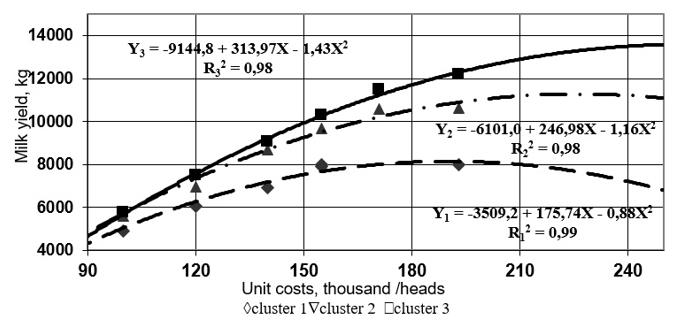
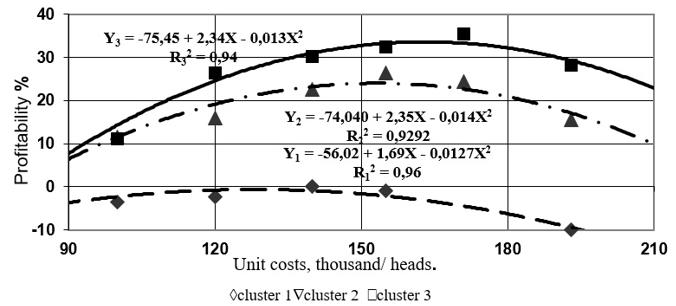
Analysis of Figure 5 allows us to conclude that the organizations of the third cluster use the available resources more efficiently. In these farms, the level of the total and specific concentration of animals is significantly higher, i.e. higher level of specialization. Here milk production is included in the list of main activities and more attention is paid to the development of dairy cattle breeding.
The direction of world trends in the development of milk production shows that its main task is to develop a breeding base, improve the breed composition of animals, and process organic waste for feed, i.e. the search for the directions of the output of the final product in the greatest quantity per unit of the consumed feed.
The results of the study of the effect of specific cash consumption on the bioconversion rate are presented in Table 4.
The graphical dependence is shown in Figure 6.
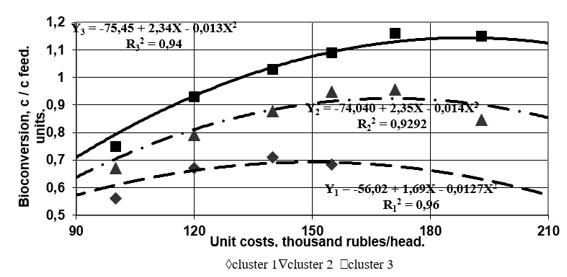
Fragmentary overlay and combination of curves of dependence of bioconversion feed on unit costs (Figure 6) made it possible to draw a graphical interpretation of the desired prospects for the development of dairy enterprises based on the use of innovations (Figure 7).
Findings
Obviously, farms of different clusters are at different stages of innovative development and their main goal is to increase milk yield and create conditions for moving to another cluster. Moreover, the higher the class, the more sensitive the bioconversion coefficient reacts to these changes. If with an increase in the level of costs from 125 to 145 thousand rubles. in farms of the first class, bioconversion increased by only 0.03 units, while in farms of the third class - already by 0.11 units, i.e. almost 4 times more.
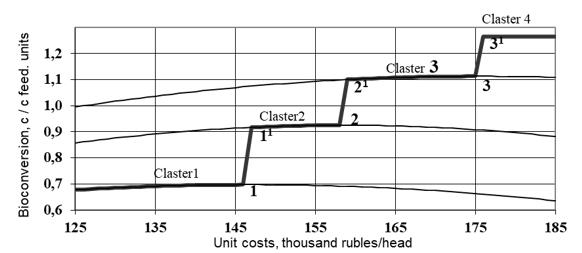
The section from the beginning to point 1 corresponds to the farms of the first cluster group, which have the lowest indicators of milk production efficiency. An increase in production costs by 21 thousand rubles/head is observed against the background of a slight increase in the effective indicator. The first level is critical, an increase in production costs does not increase the financial result and is accompanied by a decrease in the bioconversion rate.
Conclusion
Further development of organizations of the first class is possible only through an innovative leap and transition to the second class (section 1 - 11), i.e. technical and technological reorganization and re-equipment. Most often, this reorganization consists in changing the breed composition of the milking herd towards animals with a higher average productivity, which is confirmed by the data in the Table (in farms of the second class, the proportion of animals of intensive breeds is almost 2 times higher than in the first).
Subsequently, the process can be continued already at the level of the second class and the third class, respectively, at point 2 (at unit costs of 159 thousand rubles/head) and point 3 (at unit costs of 175 thousand rubles/head). It is highly probable that a fourth grade, fifth grade, etc. will appear in the future. Vertical segments of the broken line 1-11, 2-21, 3-31, etc., should be considered a graphical interpretation of the effectiveness of the use of innovations.
Thus, the results of the analysis show that the efficiency of dairy production in the region depends on a number of conditions, including the rationality of the use of production factors, the main of which is the breed composition of the dairy herd.
Acknowledgments
This paper is executed under the grant of the Russian Foundation for Basic Research No. 20-010-00089 “The Formation of Business Mechanism for Balanced Innovative Agricultural Production Development”.
References
Abalkin, L. (2012). Russia: comprehension of fate. Publishing House "Economic newspaper".
Belokh, N. V., & Rusakov, V. P. (1986). Planned balance of demand and supply of consumer goods. Nauka.
Bondarenko, S. V., & Takhumova, O. V. (2019). Economic and organizational mechanisms of forming business networks in the construction industry. P. Akimov. (Eds.) IOP Conf. Series: Materials Science and Engineering 698. 077040.
Falck, О., Heblich, S., & Kipar, S. (2010). Industrial innovation: Direct evidence from a cluster-oriented policy. Regional Science and Urban Economics, 40(6), 574-582.
Folomyev, A. N. (1995). Stability of enterprises in the market economy. Economics and organization of market economy. Progress.
Gershun, A. M., & Nefedieva, Yu. S. (2007). Development of a balanced scorecard. A practical guide with examples. Publishing house of CJSC "Olymp-Business».
Leontiev, L. I. (2002). Raw materials and fuel base of ferrous metallurgy. Akademkniga Publishing House.
Schumpeter, J. (1982). Theory of economic development. Progress.
Takhumova, O. (2020). Business Mechanism for Agricultural Production Sustainable Development Management. In E3S Web of Conferences (Vol. 208, p. 03043). EDP Sciences.
Takhumova, O. V., Vershitskiy, A. V., Kobylatova, M. F., Bludova, S. N., & Asanova, N. A. (2018). Development of Entrepreneurial Structures Of Production And Trade Sphere On The Basis Of Integration. Research Journal of Pharmaceutical, Biological and Chemical Sciences, 9(6), 1624-1629.
Tebekin, A. V., & Anastasov, M. S. (2017). Evolution of the theory of balanced development of economic systems and its modern trends. Electronic scientific journal: Businesss trategies, 2(34), 7-15.
Copyright information

This work is licensed under a Creative Commons Attribution-NonCommercial-NoDerivatives 4.0 International License.
About this article
Publication Date
25 September 2021
Article Doi
eBook ISBN
978-1-80296-115-7
Publisher
European Publisher
Volume
116
Print ISBN (optional)
-
Edition Number
1st Edition
Pages
1-2895
Subjects
Economics, social trends, sustainability, modern society, behavioural sciences, education
Cite this article as:
Takhumova, O., Bursa, I., Bondarenko, S., & Lazareva, N. (2021). Methodological Approach To Substantiating The Priorities Of Balanced Development Of Agricultural Production. In I. V. Kovalev, A. A. Voroshilova, & A. S. Budagov (Eds.), Economic and Social Trends for Sustainability of Modern Society (ICEST-II 2021), vol 116. European Proceedings of Social and Behavioural Sciences (pp. 630-638). European Publisher. https://doi.org/10.15405/epsbs.2021.09.02.70

